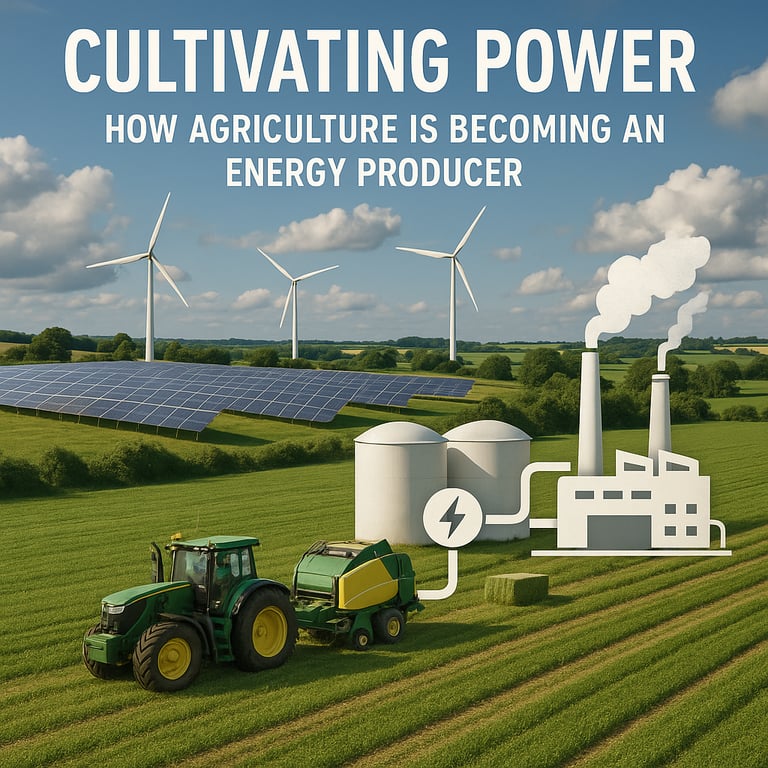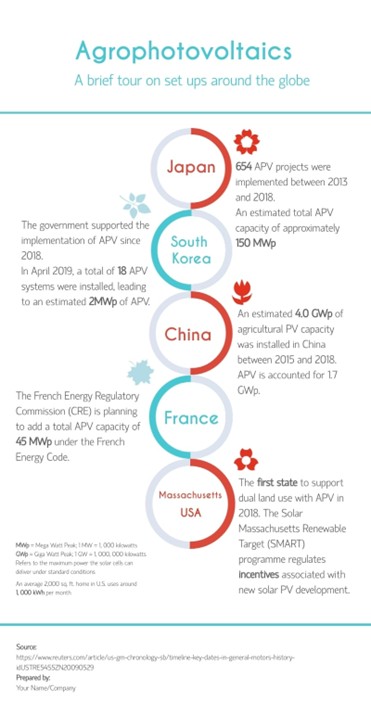Cultivating Power - How Agriculture is Becoming an Energy Producer
In the last week, we deep-dived into the staggering energy footprint of global agriculture. We saw how the immense scale of food production, from the use of diesel for planting to the natural gas embedded in every ton of fertilizer, makes farming a colossal energy consumer. Yet, this is only half of the story. The land and its bounty are not just energy sinks, but hold untapped potential to become a powerful engine of green energy generation, reshaping the energy landscape.
AGRICULTURE AND ENERGY
Aadesh Aslekar
6/30/20253 min read


A new perception is emerging in developed and industrialized countries, which view agriculture as a modern energy source, transforming farms from consumer centers into versatile hubs that produce food and generate clean, renewable energy. This dual-purpose approach is not only vital for climate action but also offers compelling solutions to energy scarcity and rural economic development.
One of the most notable examples of this transformation is biomass energy. By utilizing agricultural waste, such as crops, trees, crop residues, and manure, farmers can generate raw energy resources not only for themselves but also for energy companies that further process these materials into fuels for cars and tractors, as well as heat and power for homes and businesses. Growing and processing biofuel crops such as camelina and other oilseeds produces both the oil and the meal. The oil can be used on farms or sold for profit, and the food can be used as feed, reducing costs. This becomes a win-win for the producer.
According to the Union of Concerned Scientists, "Tripling U.S. use of biomass for energy could provide as much as $20 billion in new income for farmers and rural communities and reduce global warming emissions by the same amount as taking 70 million cars off the road." In most African countries, biomass continues to be the main energy source for subsistence activities such as cooking, heating, and lighting. Fuelwood, charcoal, and, to some extent, wood and crop residues are traditional fuels. Hence, biomass energy offers a renewable alternative to fossil fuels in sectors that are hard to electrify.
Perhaps one of the most visually striking and strategically promising innovations is agrivoltaics (or agro photovoltaics). In 1982, Goetzberger and Zastrow first proposed the concept of agro photovoltaics (APV), which aimed to modify solar power stations to enable the co-production of crops in the same region. Their idea was to raise solar collectors to 2 meters above ground, and the gap should increase to avoid the overflow of crop shade. The agri-voltaic system is where crops are grown underneath arrays of elevated solar panels. This system optimizes light penetration for crops while still maximizing energy capture. Research indicates that, in certain cases, the partial shading provided by solar panels can even benefit specific crops by reducing heat stress and water evaporation, particularly in hotter regions.


According to a study by the Fraunhofer Institute, one of the top two research institutes in Europe, in 2019, APV increased farming productivity by 160%. Out of $130 million in funding from the US Department of Energy, further research and development of solar power technologies has focused on solar agriculture. Outside the US, the technology is gaining momentum in countries of different development levels, such as Japan and India. Financial support from governments remains the most influential factor now. According to a 2020 study, the levelized cost of electricity (LCOE) of APV (€0.0828 kWh-1) is 38% higher compared to ground-mounted PV. Officials are taking stock of the evidence, and we can expect investors to follow suit.
Across continents, pilot projects and scaling initiatives demonstrate the viability of these approaches. From small-scale community biogas plants in Southeast Asia to vast agri-voltaic installations in Europe and North America, farms are demonstrating their ability to both feed the population and contribute to the grid. They represent a decentralized, resilient, and often localized pathway to renewable energy, with the added benefit of empowering rural economies.
While agriculture's leap into energy production is undeniably transformative, presenting exciting new avenues for decarbonization and energy independence, the journey towards a truly sustainable energy-food nexus isn't solely about new sources. It's also about profound efficiency and intelligence. The question remains: how can we not only generate more energy from farms but also fundamentally reduce their inherent energy demand, leveraging cutting-edge technology to farm smarter, not harder, and accelerate our collective energy transition? Our final installation will uncover the digital and innovative solutions poised to revolutionize agriculture's energy footprint.
References:
https://www.sare.org/resources/sustainable-production-and-use-of-on-farm-energy/
https://www.ucs.org/resources/renewable-energy-and-agriculture
https://www.fao.org/4/v9766E/9716609.htm
https://www.statista.com/topics/12709/bioenergy-crops-worldwide/
https://www.ebsco.com/research-starters/agriculture-and-agribusiness/energy-crops
https://www.eubia.org/cms/wiki-biomass/energy-crops/
https://waaree.com/blog/agrophotovoltaic-systems/
https://earth.org/data_visualization/agrophotovoltaics-the-benefits-of-solar-agriculture/
https://www.energy.gov/eere/solar/solar-energy-technologies-office
http://www.researchranking.org/index.php?action=ranking
https://www.sciencedirect.com/science/article/pii/S030626192030249X
Connect
info@energizetomorrowus.com
© 2025. All rights reserved.


